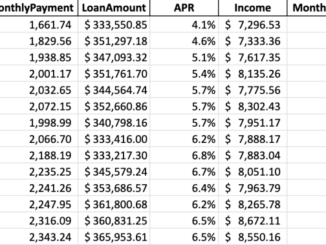
Last week, the U.S. debt ceiling impasse and the resilient economy led mortgage rates to climb to the highest level in two months. Some indexes show the 30-year fixed rate has reached the 7% mark, which has reduced borrowers’ appetite for home loans.
The latest MBA data published on Wednesday morning shows that mortgage loan applications decreased 4.6% for the week ending May 19 compared to one week earlier. The survey, conducted weekly since 1990, covers over 75% of all U.S. retail residential mortgage applications.
“Investors remained attuned to the uncertainty around the U.S. debt ceiling and communication from several Federal Reserve officials last week, which sent Treasury yields higher, along with mortgage rates,” Joel Kan, Mortgage Bankers Association (MBA) vice president and deputy chief economist, said in a statement.
“Economic data released over the past week have also pointed to a still-resilient economy. The housing market received positive data on new residential construction – which is seen as a key solution to the lack of housing inventory,” Kan added.
The MBA showed that the average 30-year fixed rate for conforming loans ($726,200 or less) rose 6.69% last week from 6.57% the previous week. For jumbo loan balances (greater than $726,200), the rate grew to 6.57% from 6.46% in the same period, according to the MBA.
However, at Mortgage News Daily, rates were even higher on Wednesday morning, at 7.01%, up six basis points from the previous day.
And, federal lawmakers have yet to reach a deal on the U.S. debt ceiling to avoid a default on June 1. That’s the date the federal government will likely no longer be able to satisfy its obligations if Congress has not acted to raise or suspend the debt limit, according to the U.S. Department of the Treasury.
“A debt ceiling crisis would delay offers from being made and delay deals already in contract from closing,” Dan Richards, executive vice president of Flyhomes Mortgage, said in a statement. “We have just started to see buyer demand pick up in recent months, so any disruption to the positive momentum would be a major setback for the industry.”
While Richards is optimistic that a deal can be reached, if they don’t, the effects could be lingering, with some reports predicting that mortgage payments will rise by as much as 20% by the fall.
“While a spike could be relatively short-lived, another obstacle on top of what buyers are already facing could cause many to withdraw from the market for the remainder of the year.”
Declines across the board
Refinancing applications declined 5% last week compared to the previous week and were 44% lower than the same week one year ago. Refis comprised 27.4% of the total applications last week, unchanged from the previous week.
Meanwhile, the purchase index decreased by 4% from one week earlier and was 30% lower than last year’s level.
“Since rates have been so volatile and for-sale inventory still scarce, we have yet to see sustained growth in purchase applications,” Kan said. “Refinance activity remains limited, with the refinance index falling to its lowest level in two months and more than 40% below last year’s pace.”
Regarding loan types, the adjustable-rate mortgage (ARM) share of mortgage apps increased to 6.7% of total applications last week from 6.5% in the previous week, the MBA data shows.
The Federal Housing Administration loans’ share rose to 12.5% from 12% the week prior. The U.S. Department of Veteran Affairs loans’ share increased to 12.5% from 12.2% in the same period. And the U.S. Department of Agriculture loans’ share grew one basis point to 0.5% of the total applications.



